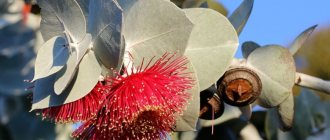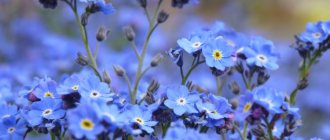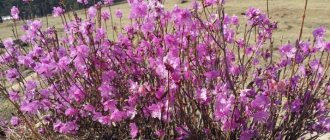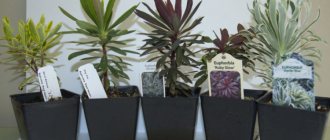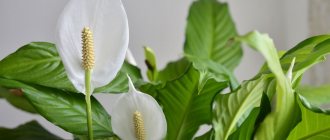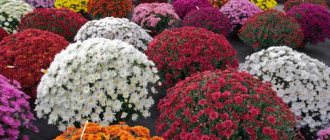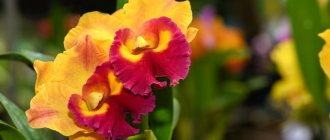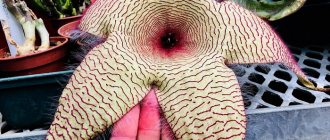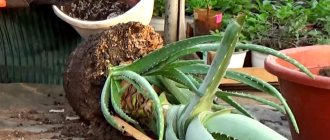From this article you will learn how to grow and maintain a blooming indoor adenium flower, photo. You can get acquainted with the variety of the plant, its types and characteristics. You will see adenium, photos and care at home, which is quite simple, but requires its own conditions, like any other indoor plant. Before buying this flower, familiarize yourself with its features and find out what harm it can cause. Take a closer look at the adenium photo and choose your favorite flower that will decorate your home.
Types of plants, appearance
Adenium flower is a plant that resembles a small tree in appearance with a thick trunk and a compaction at the base called caudex. The stem of the adenium flower curls profusely, and is decorated with numerous flowers with a blunt or pointed end.
Adenium Boehmianum
Poisonous variety. The leaves bloom only for 3 months, and they are located on the branches in a spiral.
Adenium Arabian
The leaves of this subspecies have a wide surface. Its shape is squat, with a wide base; from a distance, the differences between the branches and the trunk are not at all noticeable. The color can be red and pink, and the skin ranges from purple to brown.
Adenium Crispum
Its base resembles the shape of a turnip, which is what makes it unique. Fine roots grow from the lower part of the trunk, which is underground, while thicker roots grow at the base of the above-ground trunk. Crispum's stems are not very thick and reach 30 cm in height.
Adenium Multiflorum
It is white in color with a bright pink fringe, and is grown as a poison for hunting fish or mammals.
Adenium Oliefolium
This type of plant is the shortest of all. The flowers have a pink tint and are about 4 cm in diameter. Under natural conditions, the flower eye is white or yellow, but different varieties may have darker shades. Oliefolium blooms only in summer.
Adenium Socotra
The trunk has the shape of a column, branched. The branches are arranged in a bush-like manner and reach a height of 3 meters or more. It is quite simple to distinguish Socotrans adenium from other species: clear horizontal stripes are visible on its caudex and trunk.
Adenium Swazicum
The leaf color is light green. The flowers are solid colors, usually pink, but breeders have developed clones that are bright red, pink-purple or white. The plant needs rest, and the duration of its growth and flowering depends on the conditions in which it is grown.
Adenium Obese
Adenium obesum flowers are often pink or red in color with a white outer “neck”. It is also used as an arrowhead poison for hunting in Southern African countries.
Adenium somali
Somali adenium is very easy to grow at home; it is quite unpretentious. It is enough just to observe the rest period (November/December). The leaves have a bright green color, an elongated shape, and reach 6 - 11 cm in length and 1.7 - 2.5 cm in width. In winter, its leaves fall off.
Adenia Mini
Adenia mini is a dwarf tree with a branched crown. Flowering of mini-adeniums occurs in the second year of cultivation. The flowers are similar to roses and can reach 7–8 cm in diameter.
A similar sign
When purchasing another flower, we do not even know about some of the harmful properties of indoor plants, and then suddenly we notice emerging health problems. If a small child or animals live in the house, then you need to pay special attention to the choice of indoor flowers and plants in order to protect their livelihoods. Some types of plants contain poison in their sap or release harmful substances into oxygen.
In addition to plants that are not recommended to be kept at home, some flowers have an adverse effect on the human body. In this case, you need to choose the right location for the future green resident, without placing it in the bedroom or, conversely, in the kitchen.
There are a huge number of disputes and disagreements about dangerous plants in the house. All the sayings are mixed with various signs that can ultimately confuse a novice gardener. In this article we will look at plants with which you need to be careful and be aware of the likely consequences for the body and for energy.
List of poisonous plants
This group of plants includes those species that should not be kept at home, especially in the presence of animals or children, due to their extremely dangerous properties. A child, like a pet, can be poisoned by such flowers or get burns if handled carelessly.
If there are no children or animals in the house, then take precautions when caring for such plants. Be sure to use gloves when working with these colors and wash your tools thoroughly. Never trim these flowers with a knife meant for eating in your kitchen.
Consider this group of plants:
- Dieffenbachia. A popular indoor plant that attracts gardeners with its huge yellow-green leaves that form a fluffy crown. The flower is dangerous because of its juice, which is released when the leaves or stem are cut. If a pet or child decides to chew any part of this flower, the juice that enters the body will cause severe poisoning. In addition, Dieffenbachia juice causes burns and irritation to the skin.
- Oleander (Nerium oleander). Popular for its bright crimson flowers. Ingestion of oleander juice into the body causes blindness. The smell of a flowering plant contributes to dizziness and poor health.
- Euphorbia (Euphorbia). This plant is represented by a huge number of species and various forms, so it cannot be described unambiguously. Many representatives are similar in appearance to cacti and have spines, the injection of which is also dangerous for a living organism. Euphorbia contains white sap in its stem and leaves, which causes burns and irritation on the skin. If it enters the body it causes poisoning.
Monsterra is not a very dangerous plant, but it’s still better not to have one at home
How to grow, care and pests and diseases
Adeniums are easy to care for at home, but there are a few tips for maintaining them. The optimal temperature for the plant is +25 – 35 degrees. It is advisable to keep actively growing adenium in conditions with high air humidity. The optimal lighting for this plant is direct sunlight. The plant needs to be watered in the morning, approximately every day.
There are several pests that affect adenium with the following names: scale insects, nematodes, aphids, spider mites, mealybugs.
Adenium can have only two diseases: bacterial burn or caudex rotting. Bacterial burn occurs due to increased air humidity; the leaves begin to turn yellow. To heal a plant, you need to stop spraying it with water, remove damaged leaves, treat everything with an antiseptic and improve the soil. Caudex rot may not be noticeable for a long time, this is its danger. It happens due to excessive watering and excess moisture in the soil. It is especially noticeable in autumn or winter. When disease occurs, the leaves turn yellow and fall off, and the stem becomes very soft. If the roots are rotting, you need to cut off the stem that is higher than the rotting stem.
Caring for adenium indoors
Adenium is a low-demanding plant. But some recommendations must be followed so as not to destroy it.
Location, temperature
Adenium prefers bright and warm places. Place it on south windows. It is important to provide at least 6 hours of sun in spring and summer and a temperature of +23...+28 °C.
In autumn, the flower is moved to a cooler place (+12...+15 °C). It rests (with the exception of some species: Samali, mini) in the autumn-winter period. It is necessary to protect the plant from drafts and temperature changes.
In warm summers they are placed outside on the balcony.
Watering, humidity
Water adenium sparingly. As a rule, on hot days, once a week is enough. In other spring and summer months, only when the soil dries out. When the flower sheds its leaves, stop watering. Renew when new shoots appear.
Spray with a fine spray so that water does not flow down the trunk and leaves. Also, moisture should not get on the flowers.
Fertilizers
During the growing season, special fertilizers for cacti are added to the water for irrigation, once a month.
Transplantation, soil, pot
The root system of adenium quickly develops in width, so take a low but wide container, preferably a light shade. In dark pots, the roots of the plant overheat in the sun, which can kill it. There must be drainage holes, and in sufficient quantity, to avoid stagnation.
Young plants are replanted every year, adults - after 2, but with an annual replacement of the top layer.
The soil is taken loose, with a slightly acidic reaction. Compound:
- coarse sand, leaf, turf soil (equal parts):
- charcoal (small amount).
Mandatory disinfection of the prepared soil is necessary (warming in the microwave or fungicidal treatment). You can take a ready-made substrate for cacti.
Formation
Adenium is trimmed before the growing season begins. Two days before this, the plant is watered.
The procedure is not mandatory, but is necessary if you have specific preferences in decor. Depending on what is being formed, a tree or a bush, a different approach is required:
- tree - pruning a little less than one third;
- bush - a little more than one third.
Young plants are only pinched.
Air humidity
Only young plants need regular spraying. For older Adeniums, spraying is necessary only in the hottest time of the year , if the natural air humidity is not enough.
Newly transplanted or grafted plants may be especially sensitive to moisture. If it seems to you that the plant is suffering from a lack of moisture in the air, spray it carefully.
The spray bottle must be in perfect working order, otherwise large falling drops can cause sunburn.
Flowering plants are sprayed from a considerable distance. The spray jet should not be directed at the flowers - it is enough that a light mist appears in the air.
Reproduction methods
Adenium is not difficult to propagate, but it is important to do everything on time and correctly. True, the further preservation of varietal characteristics is controversial. Especially if you sow seeds collected from your plant after flowering.
Seeds
Seed material should be as fresh as possible. The seeds are pre-soaked in growth stimulants (Energen, Fitosporin M, Ecopin) for 6 hours. Then the seeds are placed in the prepared mixture of perlite and vermiculite and lightly sprinkled on top. Pour warm water from a syringe and cover the container with film.
A homemade greenhouse is placed in a warm place in the light. The temperature should be +26-29 0C. Shoots appear quickly - within 7-10 days. However, at the next stage, 2/3 of the weakened and deformed sprouts are eliminated. It is important to maintain the right level of heat and humidity, as well as lighting, so that the sprouts do not stretch or curl.
Important! Regularly wipe drops of condensation from the film to prevent the seedlings from rotting.
Open the greenhouse no earlier than in a month, when the seedlings have become accustomed to the microclimate in the house. They are accustomed to this gradually. First, open the film slightly for 2-3 hours a day, then twice a day. After 2-3 months, they begin to care for the seedling like an adult.
Apical cuttings
In spring and summer, the plant is propagated by cutting off several apical cuttings. During scheduled pruning, parts of branches remain that take root well under certain conditions. Dip the cutting in Kornevin for an hour, then place it in the substrate and cover with a jar.
The substrate is prepared in advance; it should be as loose and light as possible. At elevated temperatures (+27 0C), the cuttings will take root quickly, in 2-3 weeks. During this time, it should not be watered or sprayed to avoid rotting. The top of the jar is removed after a month, by which time the cutting will have strengthened and rooting will become more reliable.
Air layering
A labor-intensive and risky method of propagation, however, it gives the best chance of preserving the varietal properties of the plant. A 1-2 cm incision is made on the shoot along the entire circumference. The wound is dried and treated with Kornevin. The incision is covered with moss and bandaged with film.
Moisten the moss as it dries and keep the plant warm. Roots begin to form within 3-4 weeks. When they are sufficiently developed, the cuttings are cut off and placed in the ground. The wound on the branch is treated with Fundazol or Chlorhexidine. Copper preparations - "Oxychom" and "Kuproksat" - dry the cut well and prevent the penetration of microbes.
Layers grow well in light substrate, but their decorative value is lower than that of the mother plant. The caudex will not be as thick, and it will not be possible to grow a full-fledged bonsai from it. However, the method of reproduction does not affect flowering in any way. Air layering planted in the ground blooms in the same way as flowers grown from seeds.
Light
Adenium is a very light-loving plant .
It is recommended to keep it on the most illuminated windowsill, usually a south window.
At the height of summer there is a danger of being burned by direct sunlight.
Light shading can be provided either by taller indoor plants or by tulle or a curtain made of translucent fabric.
Description of Adenium obesum
As you can see in the photo, this is a small, beautifully flowering tree with a massive trunk. It grows slowly, but can reach two meters in length and up to 100 cm in width . The stem is gray with a brown tint, and has an expansion at the very base.
Its form depends on the place of growth; it can be bushy or woody. The leaves are leathery to the touch, spiral in appearance, up to 15 cm long, greenish-gray in color.
Adenium is valued by flower growers not only for its unusual shape, but also for its exotic flowers , which are distinguished by their diversity. They can be variegated, double and semi-double, pale and bright shades.
The evergreen bush has increased resistance to drought and prefers tropical climates. In the warm season, it is covered with a large number of corymbose inflorescences with tubular flowers of red, white, burgundy or pale pink color.
Adenium - desert rose
Adenium came to our apartments from Africa, where you can find up to 10 of its varieties. Habitat ranges from the Arabian Peninsula to Senegal and Kenya. Types of adenium differ from each other not only in the shape, size of leaves and flowers, but also in the height and width of the trunk. Adeniums grow as trees and bushes, reaching a height of five meters in their natural environment. Some varieties have a trunk girth of 2.5 meters. Adenium is a plant of the desert and arid rocky or sandy places. In such conditions, it grows slowly, and a caudex is formed at the base of the stem - a thickened trunk. On wetter soils, adenium often grows as a shrub with many trunks. It blooms in the African winter, when other representatives of the flora look dull, which is why adenium is often called the desert rose or desert rose.
Adenium grows naturally in poor, depleted soils.
Since adenium loves a hot, dry climate, it feels quite comfortable in our apartments with central heating.
Planting and transplanting
Growing adenium up to 3 years old has to be replanted frequently. Roots require a lot of nutrients and space; they will not develop normally in the same container.
Transplantation is one of the methods for forming the caudex, but this will be discussed in detail below.
These flowers are “residents” of deserts, rocky areas and plateaus with poor sandy soils. The composition of the soil for the plant is the same as for cacti and succulents: it should quickly absorb moisture and be light for better root growth.
The container should be wide and low - this way it will be possible to form the desired shape of the trunk and roots.
Landing technique:
- Larger drainage is placed at the bottom of the pot, then a substrate of soil, perlite, vermiculite and coarse sand.
- Place the tree in the ground and dig in carefully and shallowly. The roots should show slightly above the surface.
- Water a little, then put in a warm place and do not water again for at least 2 weeks. The roots need time to sprout small lateral “capillaries” necessary for nutrition.
The flower will have enough moisture obtained from the fleshy trunk. After 2-3 weeks, watering is resumed and transferred to normal mode.
Purchase and adaptation
If the plant goes on sale from abroad, it should definitely be kept in quarantine for 3-4 weeks. You cannot immediately place it with other indoor flowers - there is a risk of bacterial and viral infection. It will be difficult to cure all the plants later.
Adenium flower
Adenium, purchased already mature and flowering, requires especially careful handling.
Young cuttings grown in the same area where they were purchased are already adapted to the local climate. However, the risk of infection still remains.
Having brought home such a flower, you need to keep it separately for about two weeks and observe its growth and development. Watering, fertilizing, and pruning are excluded until the adaptation period is completed.
Features of winter care
Wintering is a difficult time, just like for its owners. The flower needs a period of rest, but with sufficient lighting and a temperature not lower than +15 ° C. Humidity should be minimal, but achieving such parameters in an ordinary apartment is not easy.
Adeniums
If you place a flower on a windowsill, it will get hot from the rising hot air from the radiators. If you move deep into the room, there will be little light. Dry air will cause the roots to dry out, but you can’t water it often - this will prevent it from fully resting. Most of the seedlings of flower growers die during this period.
Ideal winter conditions:
- +15 °C - for first-year students;
- +13-14 °C - for older flowers.
With a completely dried earthen coma, the plant can withstand a short-term drop to +10 ° C, but it is better not to experiment with this.
In early spring, the flower is gradually removed from dormancy. The temperature is gradually raised and watering begins little by little. The flower itself will give a sign when it begins to wake up - young leaves will appear from the buds. So, you can feed him a little. Give him strength to wake up from his winter sleep.
